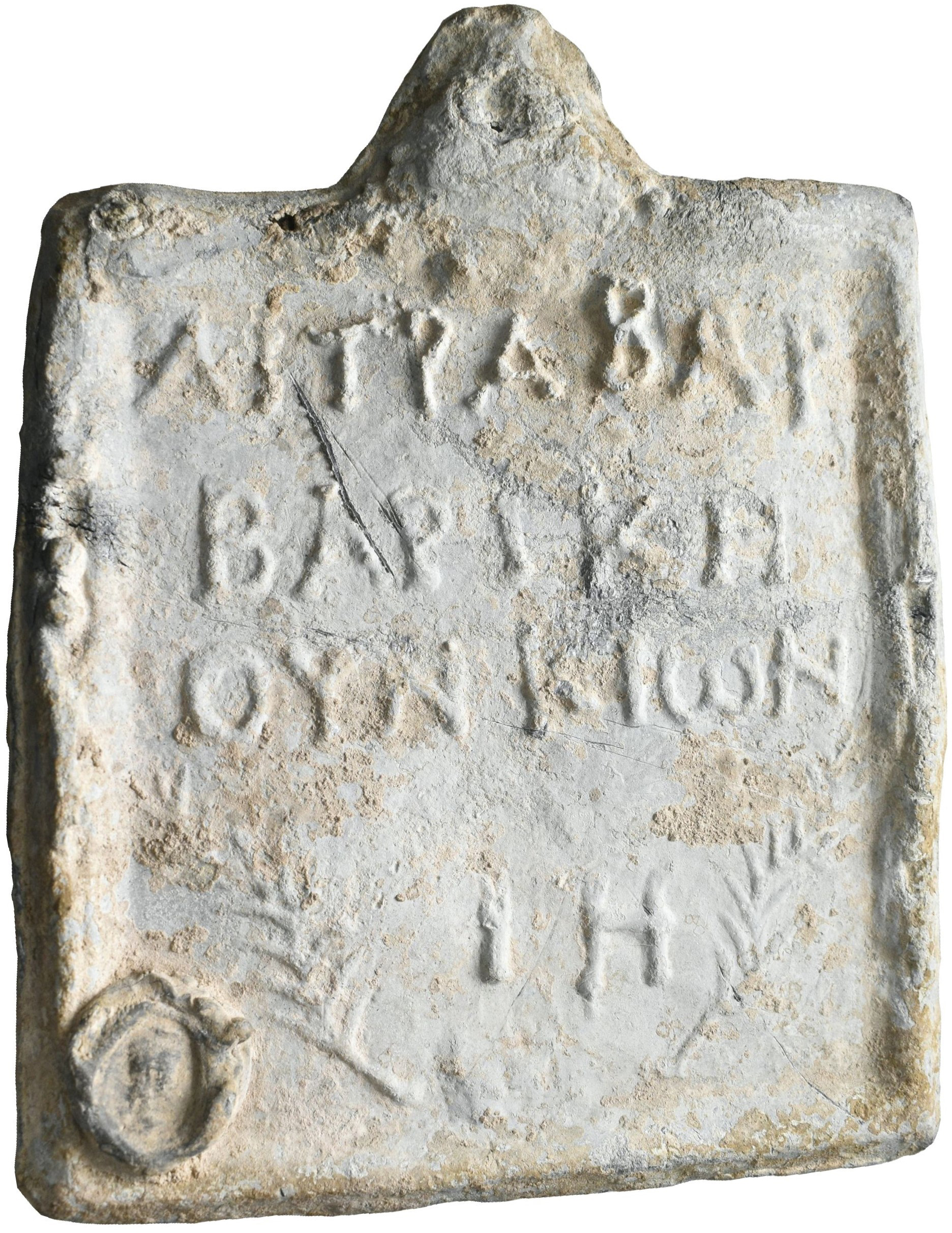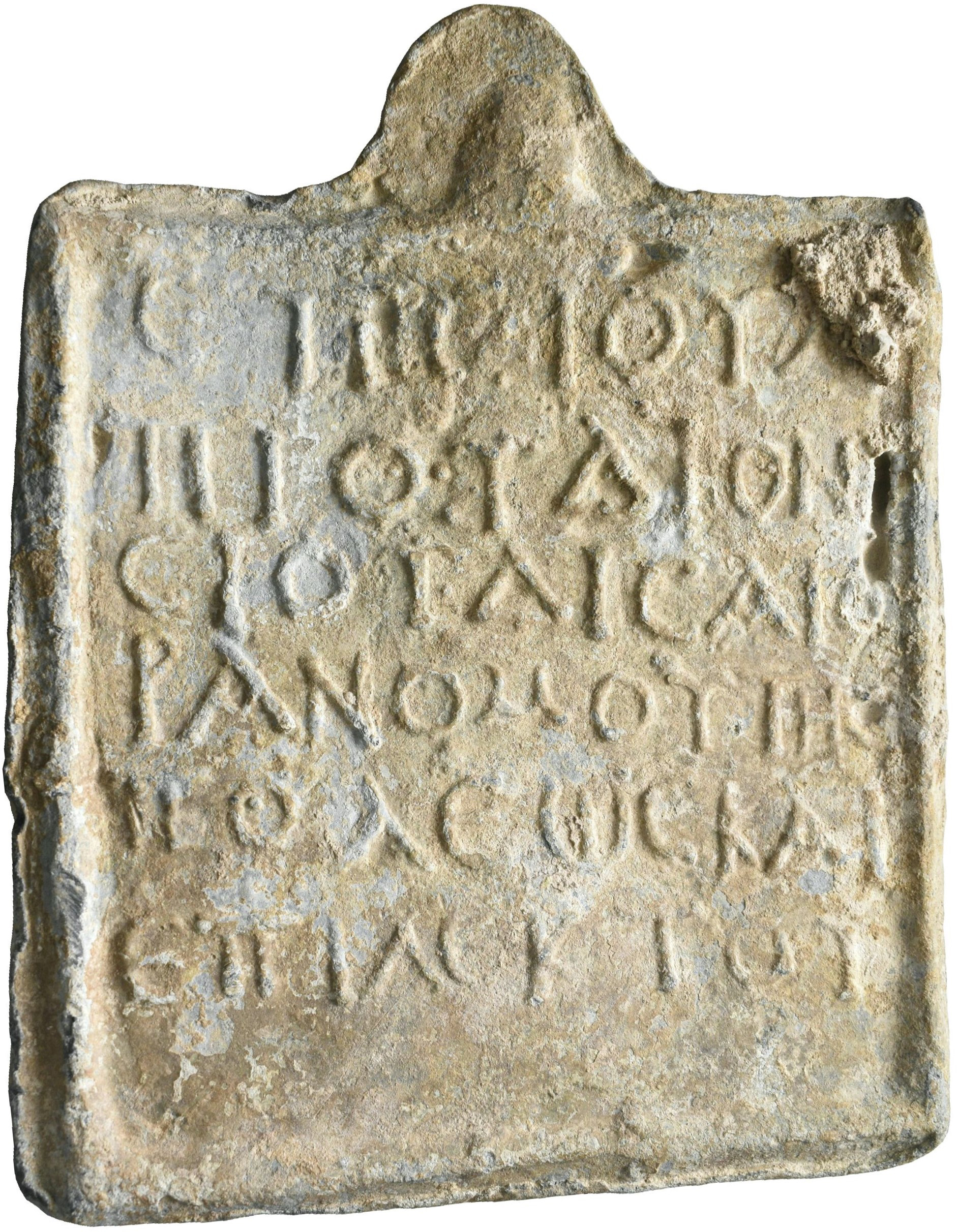
-
Copyright credit: Auction Leu 2024

-
Copyright credit: Auction Leu 2024

-
Copyright credit: Auction Leu 2024

-
Copyright credit: Private Collection

-
Copyright credit: Private Collection

-
Copyright credit: Private Collection

ARCHAEOLOGICAL DESCRIPTION OF THE WEIGHT
Authority
Caius Iulius Pius, f. Dionysios, n. Dionysios, agoramomos and epilektos
;
Caius Iulius Pius, f. Dionysios, n. Dionysios, agoramomos and epilektos
Mint
Denomination
1 Libra = 1 Litra
,
18 Uncias
Material
Lead
Manufacture
Cast
Shape
Square
Length
10.60 cm
Width
13.60 cm
Height
- cm
Metrology
| Mass (g) | Mass (grain) | Date of measurement | Reference | fragmented | cleaned | reference weight |
|---|---|---|---|---|---|---|
| 476.00 | - | - | Auction Leu 2024 | No | No | Yes |
Iconography
| Symbol | Technique | Direction | Position | Number | Synecdoche |
|---|---|---|---|---|---|
| Palm | Relief | Two | |||
| Male figure | Stamped / Countermarked / Struck | Head | |||
| Female figure | Stamped / Countermarked / Struck | Head |
Wear
Corrosion
Handle
Yes
Suspension hole
No
Recarved mould
No
Recarved weight
No
Intentionally destroyed
No
Archaeological description
Auction Leu 2024: MOESIA or BITHYNIA. Uncertain, circa 2nd-3rd century AD. Weight of 1 Litra (Lead, 106x136 mm, 476.00 g, 12 h), G. Iulius Pius, son of Dionysios, grandson of Dionysios, agoranomos of the polis and epilektos. ΛITPA BAP/BAPIKH / OYNKIⲰN / IH Two palm branches; to lower left, lead seal attached. Rev. ЄΠ Є IOYΛ / ΠIOY DION[Y]/CIOY ΔIC AΓO/PANOMOY THC / ΠΟΛЄⲰC / KAI ЄΠIΛЄKTOY. Pondera -. Unpublished and of great interest, a highly interesting piece. Minor scratches on the obverse, otherwise, very fine.
Autopsy
No
INSCRIPTION
| Language | Technique | Legend type |
|---|---|---|
| Greek | Relief | Authority, Denomination |
Fac simile
ΛΙΤΡΑΒΑΡ
ΒΑΡΙΚΗ
ΟΥΝΚΙѠΝ
ΙΗ
ѠϹ
Edition
Λίτρα βαρ|βαρικὴ | οὐνκίων | ιη´. || Ἐπὶ Γ(αΐου) Ἰουλ(ίου) | Πίου Διον[υ]|σίου δίς ἀγο|ράνομου τῆς | πόλεως καὶ | ἐπιλέκτου.
Monogram
ARCHAEOLOGICAL CONTEXT
Findspot (region)
Findspot (site)
context
CIRCUMSTANCES OF ACQUISITION
Region
City
Date of first acquisition
Sept. 8, 2024
circumstances
Antiquities trade.
DATING OF THE WEIGHT
Curatorial Section
GREEK
,
ROMAN
Time frame
FROM
100
TO
300
Comments on Chronology
COLLECTION HISTORY
Collection
| Name | Date of acquisition | Inventory number |
|---|---|---|
| Antiquities Trade | Sept. 8, 2024 | None |
Bibliography
| Reference | Page/Column | Reference (number) | Plate / Figure | Comment |
|---|---|---|---|---|
| Auction Leu 2024d | None | 1626 | None | None |
VARIA
Additional comment
The λίτρα βαρ|βαρική | οὐνκίων | ιη' "a barbaric litra, 18 uncias", is called "barbaric" in contrast to the "italic" (i.e. Roman) litra (λίτρα ἰταλική), which appears, for example, in Nicomedia (#3721) or Nikaia (#13144), and is very common in Moesia (e.g. #15671; #11469). This "barbarian" litra is a hapax, but several weights refer to a "commercial" litra (λίτρα ἀγοραία), which is heavier than the "italic" litra (usually between 14 and 20 uncias).
Auction Leu 2024: This weight is extremely intriguing in many respects. The proposed interpretation of 'ΔIC' as a genealogical repetition (i.e., 'son of ..., grandson of ...') is just one possibility. It could also indicate a second term in office for Pius as agoranomos, though our initial interpretation aligns better with common epigraphic patterns and thus seems the most likely. Even more interesting is the denomination on the obverse, which describes the weight as a 'Barbaric Litra [ΛITPA BAPBAPIKH] of 18 ounces'. This distinguishes it from the lighter 'Italic Litra', which weighed about 327 grams and is frequently marked as ITAΛIKON on weights from Moesia. Our 'Barbaric Litra' might correspond to the ΛΙΤΡΑ AΓΟΡΑΙΑ seen on some weights, which was also heavier than the 'Italic Litra' (see C. Doyen: Livres Commerciales, Livres Italiques et Mines: La Métrologie Pondérale à l'Époque Impériale, in: Simone Killen et al. (eds.): Caput Studiorum. Festschrift für Rudolf Haensch zu seinem 65. Geburtstag. Leipzig 2024, pp. 565-591). In any case, the pejorative term 'barbaric' clearly indicates that our agoranomos, G. Iulius Pius, was likely Italic. This is the first known instance of this derogatory term on an ancient weight and is thus of eminent socio-cultural significance.
Auction Leu 2024: This weight is extremely intriguing in many respects. The proposed interpretation of 'ΔIC' as a genealogical repetition (i.e., 'son of ..., grandson of ...') is just one possibility. It could also indicate a second term in office for Pius as agoranomos, though our initial interpretation aligns better with common epigraphic patterns and thus seems the most likely. Even more interesting is the denomination on the obverse, which describes the weight as a 'Barbaric Litra [ΛITPA BAPBAPIKH] of 18 ounces'. This distinguishes it from the lighter 'Italic Litra', which weighed about 327 grams and is frequently marked as ITAΛIKON on weights from Moesia. Our 'Barbaric Litra' might correspond to the ΛΙΤΡΑ AΓΟΡΑΙΑ seen on some weights, which was also heavier than the 'Italic Litra' (see C. Doyen: Livres Commerciales, Livres Italiques et Mines: La Métrologie Pondérale à l'Époque Impériale, in: Simone Killen et al. (eds.): Caput Studiorum. Festschrift für Rudolf Haensch zu seinem 65. Geburtstag. Leipzig 2024, pp. 565-591). In any case, the pejorative term 'barbaric' clearly indicates that our agoranomos, G. Iulius Pius, was likely Italic. This is the first known instance of this derogatory term on an ancient weight and is thus of eminent socio-cultural significance.
Permalink
External link